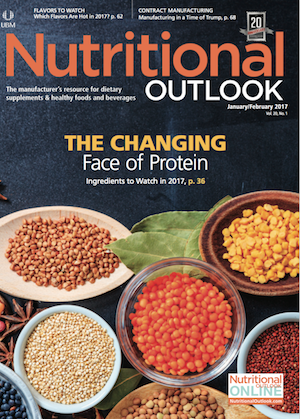2017 Ingredient Trends to Watch for Food, Drinks, and Dietary Supplements: Probiotics
In 2017, probiotic-industry leaders are taking steps to protect their market position by ensuring that bad actors aren’t misleading consumers with mislabeled products.
Photo © iStockphoto.com/royaltystockphoto

Probiotic sales were a tour de force last year. According to SPINS, in the United States probiotics were the number-one bestselling ingredient in the natural supplement channel, with 18% growth in 2016. In the mainstream multi-outlet channel, probiotics came in at number two, with 17% growth.1 Probiotic performance is also strong globally, with market researcher Euromonitor reporting last fall that the global sum of all probiotic products-probiotic supplements, probiotic yogurts, and sour milk products-amounted to $40 billion in 2015.
Probiotic supplement sales are especially promising in North America, according to Euromonitor. Probiotics will be the fastest-growing type of supplement in North America through 2021, predicted Ewa Hudson, Euromonitor’s global head of health and wellness, nutrition, and ethical labels, at the SuppySide West trade show last fall. “This is really spectacular performance, so I really hope you will make the most out of that opportunity because things like that don’t happen that often. Other industries only dream of these figures to be projected for them," Hudson told probiotic firms.
No one should take this kind of growth for granted, and that’s why in recent years-and into 2017-probiotic-industry leaders are taking steps to protect their market position by ensuring that bad actors aren’t misleading consumers with mislabeled products. In January, the International Probiotics Association (IPA), together with the Council for Responsible Nutrition (CRN; Washington, DC), issued voluntary guidelines for the labeling, storing, and stability testing of probiotic supplements and functional foods/beverages. The guidelines were developed by a working group comprising 37 of the probiotic industry’s leading ingredient and finished-product manufacturers.
The hope for these guidelines is that they will increase transparency within the probiotic market so that consumers can better understand what is actually in a product, says David Keller, DPM, vice president of scientific operations for probiotics supplier Ganeden (Cleveland), who chaired the committee responsible for writing the guidelines.
The basic tenet of the guidelines is that product manufacturers should be specifying, down to the strain level, exactly what type of probiotic is in their product, because probiotic health benefits are extremely strain-specific. “You also need to say how much is in there when the product is actually consumed by the customer-not on the day the product was manufactured,” says Mike Bush, president of Ganeden and president of the board of directors for IPA. The IPA/CRN guidelines also recommend that firms label their products in terms of colony-forming units (CFUs), echoing a citizen petition IPA sent to FDA in November asking the agency to require probiotic labeling in CFUs instead of by weight (milligrams). And, above all, manufacturers should use efficacious doses supported by scientific evidence.
Most probiotic leaders are already operating by these best practices, says Bush. “I’d say that a majority of the companies that are involved in this industry are in favor of transparency and labeling and making sure the consumer is getting what they’re paying for. We live and die by that. We know the folks at DuPont and Probi and Chr. Hansen and Lallemand-I could go on and on-feel incredibly responsible to their consumer that if they’re going to have faith in them to buy something they should know what they’re buying.”
Bad actors do exist, however, and run the risk of tarnishing the reputation of the entire probiotics category. “There’s a reason that people aren’t labeling the strain, and we think that in a lot of cases it’s because the strain that they’re using is inexpensive and has no clinical data behind it,” says Bush. “So we as an industry are hoping to see that it becomes more clear so that people aren’t trying to mislead consumers by putting generic strains-labeling just the genus and species but not labeling the strain.”
Keller says, “We would like to see [these guidelines] adopted by all companies selling probiotic products, which will raise the quality of the industry as a whole. It will also be a document for regulators, consumers, and purchasers to consider, to better understand what they are purchasing.”
“We believe these guidelines will raise the bar for the probiotic industry,” said George Paraskevakos, executive director of IPA, in a press release.
And that seems to capture the mood in the probiotics industry these days, with more companies working to develop better ways to identify probiotic strains and quantify probiotic content. It’s why DuPont Nutrition & Health (Wilmington, DE) announced last year that it’s developed new methods for identity testing the strains in a multi-strain probiotic blend using a specific type of DNA analysis. It’s also why probiotics supplier Pharmachem Laboratories (Kearny, NJ) says it is now using flow cytometry in order to better measure the viable cells in a probiotic formula-a method the company says more accurately measures viable content compared to standard plating techniques that only measure CFUs. By better characterizing these popular products in 2017 and onward, probiotic manufacturers and suppliers will help to boost industry transparency and, ultimately, long-term credibility.
Also read:
New DNA Test Method Lets Probiotic Firms Test Multistrain Blends: SupplySide West Report
Measuring Probiotics in CFUs Only Gives Part of the Story, Pharmachem Says of Move to Flow Cytometry
A 2016 Update: Promising New Science on Probiotics
2017 Ingredient Trends to Watch for Food, Drinks, and Dietary Supplements:
Plant Protein vs. Dairy Protein
Hemp CBD, Vinpocetine, and Kratom
Jennifer Grebow
Editor-in-Chief
Nutritional Outlook magazine
jennifer.grebow@ubm.com
References:
- Sales numbers courtesy of SPINS, covering the 52 weeks ending November 27, 2016.

Prinova acquires Aplinova to further increase its footprint in Latin America
April 7th 2025Prinova has recently announced the acquisition of Brazilian ingredients distributor Aplinova, which is a provider of specialty ingredients for a range of market segments that include food, beverage, supplements, and personal care.

























